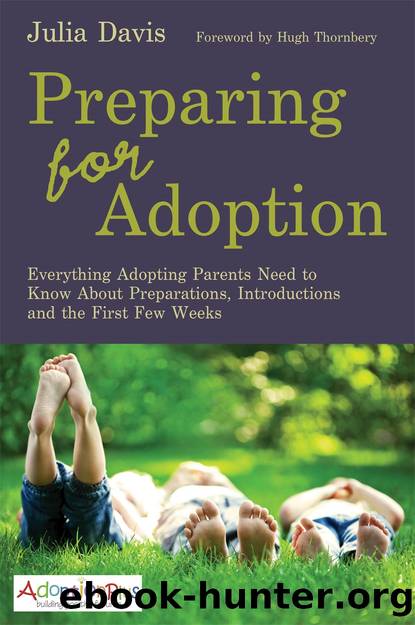Preparing for Adoption by Davis Julia

Author:Davis, Julia [ Davis, Julia]
Language: eng
Format: epub
ISBN: 9780857008312
Publisher: Jessica Kingsley Publishers
Published: 2014-09-27T00:00:00+00:00
Placing sibling groups
Planning introductions for siblings needs to take account of their ages, developmental needs and the dynamics of being a sibling group rather than just a single child. One of the key issues is whether to place siblings all at the same time or to place them one by one.
When brothers and sisters are placed together at the same time, this may mirror their experience in foster care as they will already have established a pattern as a sibling group. Placing them at the same time prevents any âpecking orderâ or jealousy arising. Children who have always lived together, particularly very small children, may be extremely distressed if they are suddenly separated when one moves without the other.
If siblings are all placed at the same time you might find it hard to have any one-to-one time with each child and find it exhausting trying to meet all their individual needs. There is also a risk that one child will be overlooked or you might miss their cues that they need your attention if another child is more overtly demanding of your attention. Spend some time thinking about their attachment patterns before they came to you and how they signal their needs â and how this might be affected by being a sibling. You might discover one sibling is much more self-reliant than the other who seeks out your attention and you will need to remember this when you are trying to build an attachment relationship with both of them. Other sibling groups may have developed very strong bonds with each other as a way of surviving their early trauma. They may have a stronger sense of loyalty to each other than to you as an unknown adult. One child may have taken on the role of âparentified childâ and see their role as that of parent to their younger siblings. In your home they may want to continue in this role and may struggle with you over who does the looking after when their siblings need care. This can be a challenge in terms of making your own connection with each child. Spending time with each child individually will help build the relationship. In times of stress they may seek each other out rather than a grown-up as, in their world, they have not been able to rely on the grown-ups around them to take care of them in the past. Your task will be to teach them that they can rely on you to keep them safe.
Sharanjit and James adopted Katy, aged two and Joseph, aged one. The children had always lived together in the same foster placement and the social worker wanted them to move together to live with Sharanjit and James. On the way over to their first meeting, Sharanjit expressed some qualms about managing two such young children, thinking that it would be almost like having twins. She worried about how they would cope with the foster carer watching them parent for the first time. The foster carer set her at ease straightaway as she talked them through the childrenâs routines.
Download
This site does not store any files on its server. We only index and link to content provided by other sites. Please contact the content providers to delete copyright contents if any and email us, we'll remove relevant links or contents immediately.
Spare by Prince Harry The Duke of Sussex(4807)
For Baby's Sake(4515)
Tuesdays with Morrie by Mitch Albom(4415)
Machine Learning at Scale with H2O by Gregory Keys | David Whiting(3674)
Never by Ken Follett(3554)
The Five People You Meet in Heaven by Mitch Albom(3342)
Fairy Tale by Stephen King(2981)
Reminders of Him: A Novel by Colleen Hoover(2783)
Will by Will Smith(2596)
The Clitoral Truth: The Secret World at Your Fingertips by Rebecca Chalker(2590)
Tuesdays With Morrie by Mitch Albom(2582)
Borders by unknow(2122)
The Body Keeps the Score by Bessel van der Kolk MD(2087)
Cruel to Be Kind by Cathy Glass(2056)
Friends, Lovers, and the Big Terrible Thing by Matthew Perry(2019)
The Stranger in the Lifeboat by Mitch Albom(1947)
Finding Chika by Mitch Albom(1888)
Love on the Brain by Ali Hazelwood(1830)
New Morning Mercies: A Daily Gospel Devotional by Paul David Tripp(1822)
